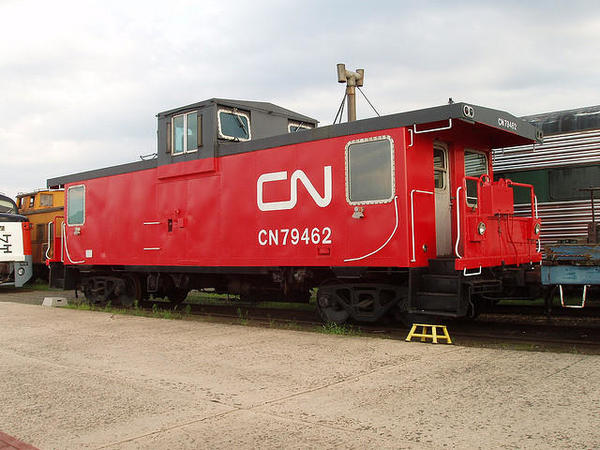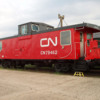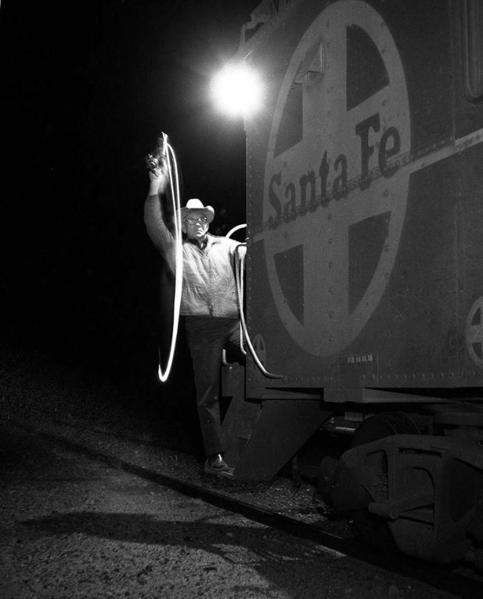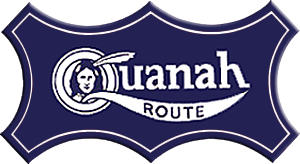.
Replies sorted oldest to newest
Was changing orders on the fly like this a common occurrence? Or did it just happen when a train got held up by mechanical breakdown or some other reason? I notice the line for "Time" was left blank. How far apart were these orders received?
"I notice the line for "Time" was left blank. How far apart were these orders received?"
Look in the "Time Completed" box at the lower left.
I was looking at the Time space at the top of the page. Didn't even notice that at the bottom. Guess I need to pay better attention. ![]()
I was wondering if this was ABS or dark territory?
But if I do go to Clearmont for him it will be a Red Board meet there. Look out!
Not the best situation but the west bound (even on a red board ) still must be prepared to stop at the siding switch where an opposing train clears. In this case at the east switch.
I don't see Wyhogs running order.
It would not be uncommon to have 25 or more train orders which included meets slow orders etc
I think you made a typo there, Gregg. You meant the west switch.
You're right...Good thing I'm retired.![]()
In the day before computers help to dispatch, how did a DS make sure there was never a "lap" order?
Once on the Amtrak LONE STAR, I came out of the restroom on the lower level of an ex ATSF high level chair car. The condustor was getting his orders. He got a fist full of them, including the clearance!
Without actually knowing, it looks to me like most everything ran extra on that sub. Did your stack of orders ever include flag protection? How was that managed?
It was managed by a train order , Form U , (rear end)
Ex...Westward extra trains except Extra 765 wait at G until ten thirty.
Gregg posted:It was managed by a train order , Form U , (rear end)
Ex...Westward extra trains except Extra 765 wait at G until ten thirty.
On a roadswitcher that always ran extra, occasionally we would not get a flag protection order so we would have to flag with torpedoes and lantern. The trainmaster orchestrated this to see if we could actually protect a train. This was in the days of full crews.
Running up the canyon to Bend Oregon on the UP the basic rule was "don't run into anybody." Most of the time the radio would not reach out of the canyons and we regularly had to stop at a land-line shack to contact the dispatcher to find out who was where and when. Lots of fun. And the rafters flashing us ... that added interest to the run.
" In cold weather being a flagman was not fun."
That was my thought, and motivation for bringing it up.
You write well enough for the reader to be "in the cab" or "out in the cold" with railroad men. Thank you.
Back in the day, was there an emergency cord in the caboose where somebody could pull the air if something was going wrong?
Dominic Mazoch posted:Back in the day, was there an emergency cord in the caboose where somebody could pull the air if something was going wrong?
Not a "cord", but there was a valve in the caboose that could be used to dump the air.
Wyhog- thanks for sharing this, its always interesting to learn how things used to be done.
Yep there was a notched valve in the cupola that you could slowly apply the brakes, however it had a pin in it so you couldn't release the brake... However most of us just used it for an emergency brake application, Most hoggers didn't like anyone messing with it for good reason.
There was also a emergency valve at each end of the platform next to the whistle and hand brake. Still one more option ,,,,,,the rear hose bag angle cock.
 The modern steel CN cabooses had a cord near the Conductors desk at each end of the caboose.
The modern steel CN cabooses had a cord near the Conductors desk at each end of the caboose.
Attachments
Wyhog posted:YI never trusted a lot of the guys to get stopped in these situations so always approached Red Board Meets with caution and trying to talk to them on the radio.
You must have been reading my mind, Al . . . or maybe I was reading yours.
Always place torpedo on engineer side so you dont wake up the conductor !
Dominic Mazoch posted:Back in the day, was there an emergency cord in the caboose where somebody could pull the air if something was going wrong?
On one of the SPS700 excursions the power car behind the tender started to derail and the conductor in the tail car pulled the emergency handle.
That turned out to not be too good a move as it caused some bunch-stacking making the derailment worse.
Passengers rode the bus back to Portland.
Kerrigan posted:Dominic Mazoch posted:Back in the day, was there an emergency cord in the caboose where somebody could pull the air if something was going wrong?
On one of the SPS700 excursions the power car behind the tender started to derail and the conductor in the tail car pulled the emergency handle.
How did the Conductor, all the way at the rear of the train, know about the power car problem RIGHT BEHIND the tender? If someone called him on the radio, why wasn't the Engineer called on the radio? Something doesn't sound right.
That turned out to not be too good a move as it caused some bunch-stacking making the derailment worse.
Passengers rode the bus back to Portland.
Hot Water posted:Kerrigan posted:Dominic Mazoch posted:Back in the day, was there an emergency cord in the caboose where somebody could pull the air if something was going wrong?
On one of the SPS700 excursions the power car behind the tender started to derail and the conductor in the tail car pulled the emergency handle.
How did the Conductor, all the way at the rear of the train, know about the power car problem RIGHT BEHIND the tender? If someone called him on the radio, why wasn't the Engineer called on the radio? Something doesn't sound right.
That turned out to not be too good a move as it caused some bunch-stacking making the derailment worse.
Passengers rode the bus back to Portland.
Someone on the radio hollered "we're on the ground!" and he pulled the plug causing the remainder of the train to bunch. The headend was still pushing when it all happened in less than a couple of seconds. I was standing next to him and had just said "I'd be tip-toeing through this puzzle" when it went to ground. He yanked it before anyone could think. In retrospect it at the speed we were moving it probably wouldn't have made any difference to let the head-end do the stopping.
So, the train was being shoved backward by engine SP&S 700, through turnouts, when the first car behind the tender derailed?
If that's correct, was the Engineer shoving the train against a minimum brake pipe reduction (train brakes applied lightly to control slack when shoving - not required but sometimes done to prevent run-out of slack) ?? Knowing how the train was moving, what speed, which direction would help in understanding how this this derailment was made worse by an emergency brake application made from the rear car.
Back to the topic of How We Used to Railroad:
When we took siding in ABS territory and went to beans, we took the lead strap from a torpedo and stuck it upright into a rail joint, so that, when we returned, we would know if any train had passed, and could call the DS and find out which train(s) and compare them with our train orders. With almost no open train order offices, that's the only way we could tell which extras had been met when we were eating or whether the passenger train was displaying green signals.
CLARIFICATION: I just re-read what I wrote, and I think it could be misleading. The lead strap was just confirmation that some train had run on the main track while we were gone. It was the call from the phone booth to the DS that informed us what train had passed and if green signals had been displayed.
I wish I knew whom to credit for this photo. It was posted on a large and active, but rather immature FB group that I monitor because it sometimes produces a jewel. This photo belongs on this thread.
Attachments
"Hi ball , Let's go."
Wanting to continue this fine thread, I submit the following: a recent 3-way email conversation between myself, author Steve Goen, and a BN, Inc. maintenance foreman (notice another unreconstructed man referring to himself as Frisco, as it shall always be). It regards the abandonment and razing of the QA&P from Floydada to Paducah, TX in 1981-82.
Hi Steve - Robert Leese posted to the Ship It On The Frisco Group on Facebook that he had gotten a DVD titled "Ship It on the Frisco" and that had footage of taking up the QA&P. I was the person in charge of abandoning the QA&P. "Manager of Rail Trains" on the Frisco at the time.
I will be sending you a check to get a copy of the DVD in the near future, but I thought I would tell you a couple of stories about the job.
First, the train crew was great. I don't know how much you know about RR operations, but normally it requires authority of the train dispatcher to operate trains. In this case they put out a General Order giving all train operation authority to the Maintenance of Way, i.e. me. Never heard of such a thing before, or since for that matter.
Second story requires a little background.
First, I was using the two Frisco 'Rail Replacement Gangs' (45 man each) to do the abandonment. Because they worked over the complete Frisco they would work all of the work days of the month (20 or 21 ish) in a row and then take the rest of the month off.
Second, I remember two things the Frisco did every year to wine and dine the 'big' shippers. First was running a business car special to the Liberty Bowl in Memphis. The second was taking the business cars out on the QA&P and park them (along with the porters, cooks & bar tender) to go bird hunting. They would round up 3 or 4 hy-rails for the officials and customers to hunt out of.
Now for the story.
Communications back then was not what it is today, so they got hold of the Agent at Quanah and sent him out to find me and tell me to call the Chief Engineers office in Springfield. The gist of the conversation was they realized how long we were working and how fast we were going and they wanted to have one last hunt for the big spenders and would prefer that I not run over any of the hy-rails with my work train so they wanted me to stop all operations on Sunday (as I recall). I hope the hunt was worth it because normally it would have been a big deal to have two men sitting around for half a day, but 60 men all day, not so much. Never did hear if they had a good hunt.
Name withheld (by RRLeese)
Topeka, KS
In the past, the SW portion of SLSF was alleged to be notorious for quail hunting from the R-O-W, but I am here to affirm that the accusation was absolutely true, hehe! And it the spirit moves us, there is more to tell...
Another example of "How it used to be".
Attachments
That throwing of the fusee in the air to signal the head end that all were aboard and ready to go sometimes went badly, if it was not used with common sense. A Santa Fe Brakeman (who had just enough experience to think he was a lot more experienced than he actually was), who had been shown that procedure at a remote siding on the plains, arced one skyward at Birds, Texas, and burned down a house.
In my time, locomotives and cabooses, were supplied with both yellow and red fusees. Yellow was intended for signaling to the engineer of the train, directing train movements, such as a highball as described above or desired switching moves. Red fusees were intended (and defined by rule) as conveying a stop signal only. This, however, was not strictly adhered to as yellow fusees were for the most part, neglected. The particular motion of the arm signaled by the conductor or trainman of the fusee communicated the desired movement of the locomotive/train to the engineer, much like the hand signals relayed today from a ground person to the pilot of an aircraft spotting up on the tarmac at an airport.
Chris
Number 90 posted:That throwing of the fusee in the air to signal the head end that all were aboard and ready to go sometimes went badly, if it was not used with common sense. A Santa Fe Brakeman (who had just enough experience to think he was a lot more experienced than he actually was), who had been shown that procedure at a remote siding on the plains, arced one skyward at Birds, Texas, and burned down a house.
Or on one occasion I know of, the lighted fusee landed in a load of coal ahead of the caboose. After being flagged down by a tower operator 20 or so miles down the road, the car was set out, the fire department of the small town where the set off track was notified, and the company phone lines/communication system on the telegraph poles along the right of way was buzzing. As with any serious incident, in railroad jargon this was known as the "wires being hot" only in this instance, they literally were….
Rob Leese posted:
OK, got it. After some research I find that a former ATSF conductor from Amarillo named Clyde Stickley is the photographer. He has posted some of his work on FB, and it shows that he has a great talent at photography as well as an artistic eye for composition.
As I mentioned before, I saw this photo on a closed FB group known as "If you work(ed) on the railroad" which I highly do not recommend because of the mindless vulgarity displayed 99% of the time. However, sometimes a contributor will produce a treasure like this photo.
I remembered when someone post about the other colors of fusees my dad a engineer when i was say 10 or so bringing home boxes of fusees for 4th of july. about five houses on my street in order 20 fusees each lighted red ,yellow, green, all at the same time !!! it was magnificent !!! and the molten hardened white residue all over the curbs the next morning........good times brought to us by the NEW YORK CENTRAL !
'Mindless vulgarity'. Whatever ever happened to the fine art of eloquent profanity? It's not the word, but how it used in a sentence. Alas, perhaps just another sign of the decline of decent society.
On the topic of vulgarity.........the guys i worked with and im talking about 95 % of them couldn't say three words without a f bomb splice. One day a car inspector was giving me a ride and i was sitting on the mike and the line was VERY open. I decided to rip each and every one of my supervisors with my profanity laced opinion of them. They must have agreed because nothing was ever said to me. However i did apologize to the Terminal Supt. and i explained that when you use someones name with a lot of vulgarity its a term of endearment ! If you leave the vulgarity out , you probably don't like them. All he said to me was to try to curb my enthusiasm. Conrail john
That's the truth! I never swore much, unless I was really upset, until I worked for the railroad...
One time my wife, now ex, called me at work and said she heard me talking about getting some morning thunder to my dispatcher. I had dialed the phone in my pocket to home inadvertently and she heard the conversation. I told her I'll be home for lunch. Cheers.
Well we are no longer permitted to say "check the cock on the end" or any other versions unless we include "angle" first, as someone got the Diversity Counsel involved ![]()
its now a "kinder, gentler" work place ![]()
Laidoffsick posted:Well we are no longer permitted to say "check the cock on the end" or any other versions unless we include "angle" first, as someone got the Diversity Counsel involved
ROTFL!
Now THAT'S funny...
I guess you'll just need to put that cock usage away when not alone ![]()
You'd think the chicken farms would have keep them too busy to bother.
Pretty silly really, either might be angled ![]()









